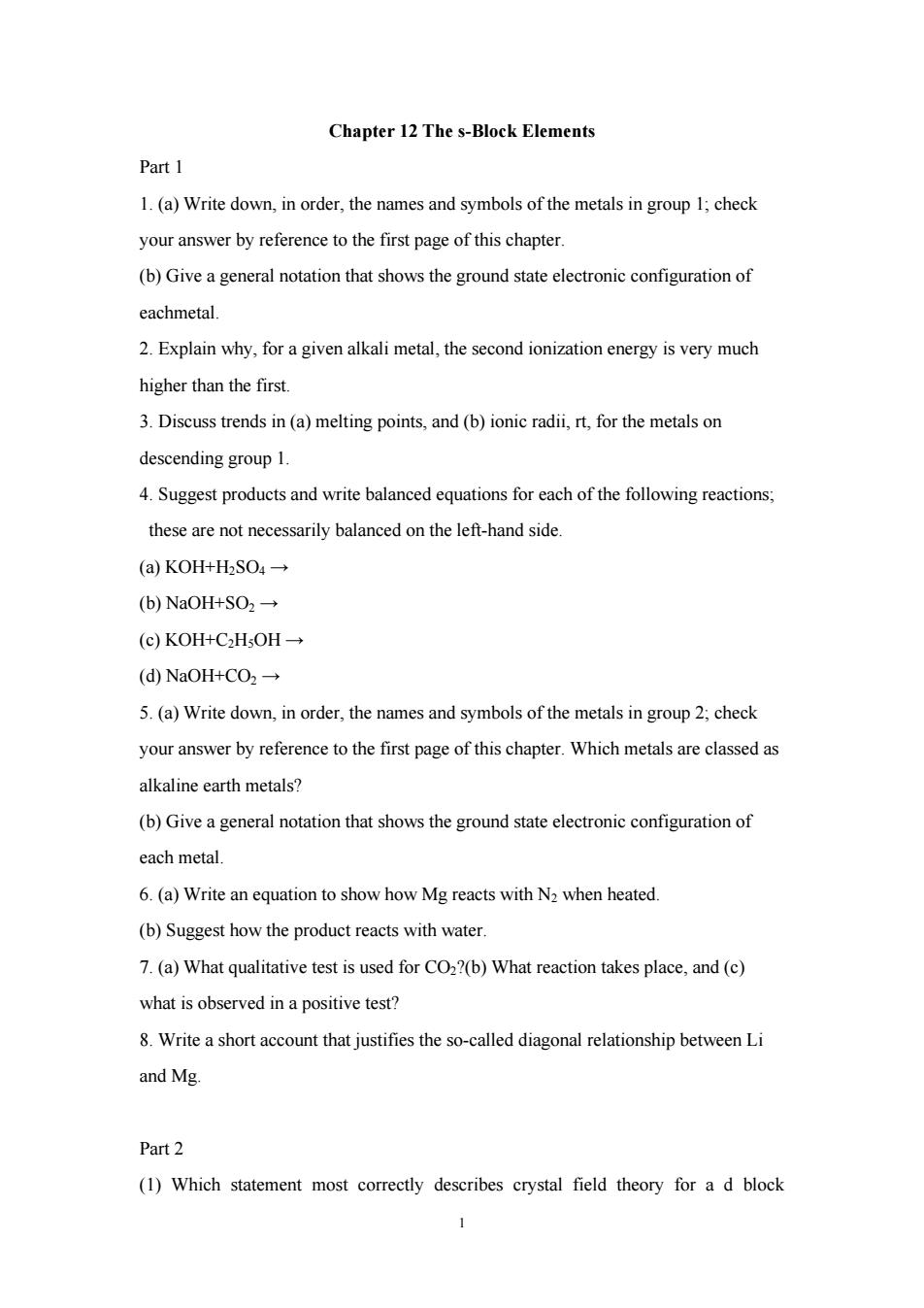
Chapter 12 The s-Block Elements Part1 1.(a)Write down,in order,the names and symbols of the metals in group check your answer by reference to the first page of this chapter (b)Give a general notation that shows the ground state electronic configuration of eachmetal. 2.Explain why,for a given alkali metal,the second ionization energy is very much higher than the first. 3.Discuss trends in(a)melting points,and(b)ionic radii,rt,for the metals on descending group 1. 4.Suggest products and write balanced equations for each of the following reactions these are not necessarily balanced on the left-hand side (a)KOH+H2SO.4→ (b)NaOH+SO2→ (c)KOH+C2HsOH- (d)NaOH+CO2→ 5.(a)Write down,in order,the names and symbols of the metals in group2:check your answer by reference to the first page of this chapter.Which metals are classed as alkaline earth metals? (b)Give a general notation that shows the ground state electronic configuration of each metal. 6.(a)Write an equation to show how Mg reacts with N2 when heated (b)Suggest how the product reacts with water. 7.(a)What qualitative test is used for CO2?(b)What reaction takes place,and(c) what is observed in a positive test? 8.Write a short account that justifies the so-called diagonal relationship between Li and Mg. Part2 (1)Which statement most correctly describes crystal field theory for a d block 1
Chapter 12 The s-Block Elements Part 1 1. (a) Write down, in order, the names and symbols of the metals in group 1; check your answer by reference to the first page of this chapter. (b) Give a general notation that shows the ground state electronic configuration of eachmetal. 2. Explain why, for a given alkali metal, the second ionization energy is very much higher than the first. 3. Discuss trends in (a) melting points, and (b) ionic radii, rt, for the metals on descending group 1. 4. Suggest products and write balanced equations for each of the following reactions; these are not necessarily balanced on the left-hand side. (a) KOH+H2SO4 → (b) NaOH+SO2 → (c) KOH+C2H5OH → (d) NaOH+CO2 → 5. (a) Write down, in order, the names and symbols of the metals in group 2; check your answer by reference to the first page of this chapter. Which metals are classed as alkaline earth metals? (b) Give a general notation that shows the ground state electronic configuration of each metal. 6. (a) Write an equation to show how Mg reacts with N2 when heated. (b) Suggest how the product reacts with water. 7. (a) What qualitative test is used for CO2?(b) What reaction takes place, and (c) what is observed in a positive test? 8. Write a short account that justifies the so-called diagonal relationship between Li and Mg. Part 2 (1) Which statement most correctly describes crystal field theory for a d block 1

complex of unspecified geometry? A)The theory considers covalent interactions between a metal centre and the surrounding ligands B)The theory considers electrostatic interactions between a metal ion and the surrounding ligands which are taken to be point charges C)The theory rationalizes the non-degeneracy of the metal d orbitals by considering the electrostatic repulsions between point charge ligands and electrons in the metald orbitals D)The theory rationalizes why the metal d orbitals are split into two levels (2)Which of the following correctly places the ligands in their order in the spectrochemical series? A)Br-<Cl-<NH3<H20 B)-<Br-<H20<[OH C)F-<CI-<H20<NH3 D)I-<Cl-<H2O<en (3)Which of the following correctly places the metal centres in their order in the spectrochemical series? A)Mn(II)<Fe(III)<Rh(III) B)Cc(I)<Co(D<Rh(四 C)Pt(IV)<Pd(II)<Ni(II) D)Pd(ID)<Ni(ID)<Pt(IV) (4)Which metal complex ion is expected to be subject to a Jahn-Teller distortion? [Cr(OH2)] B)[Cr(NH3)6 C)[Cr(CN)] D)[Cr(bpy)
complex of unspecified geometry? A) The theory considers covalent interactions between a metal centre and the surrounding ligands B) The theory considers electrostatic interactions between a metal ion and the surrounding ligands which are taken to be point charges C) The theory rationalizes the non-degeneracy of the metal d orbitals by considering the electrostatic repulsions between point charge ligands and electrons in the metal d orbitals D) The theory rationalizes why the metal d orbitals are split into two levels (2) Which of the following correctly places the ligands in their order in the spectrochemical series? A) Br– < Cl– < NH3 < H2O B) I– < Br– < H2O < [OH]– C) F– < Cl– < H2O < NH3 D) I– < Cl– < H2O < en (3) Which of the following correctly places the metal centres in their order in the spectrochemical series? A) Mn(II) < Fe(III) < Rh(III) B) Co(III) < Co(II) < Rh(III) C) Pt(IV) < Pd(II) < Ni(II) D) Pd(II) < Ni(II) < Pt(IV) (4) Which metal complex ion is expected to be subject to a Jahn-Teller distortion? ) [Cr(OH2)6] 3+ B) [Cr(NH3)6] 2+ C) [Cr(CN)6] 3– D) [Cr(bpy)3] 2+ 2
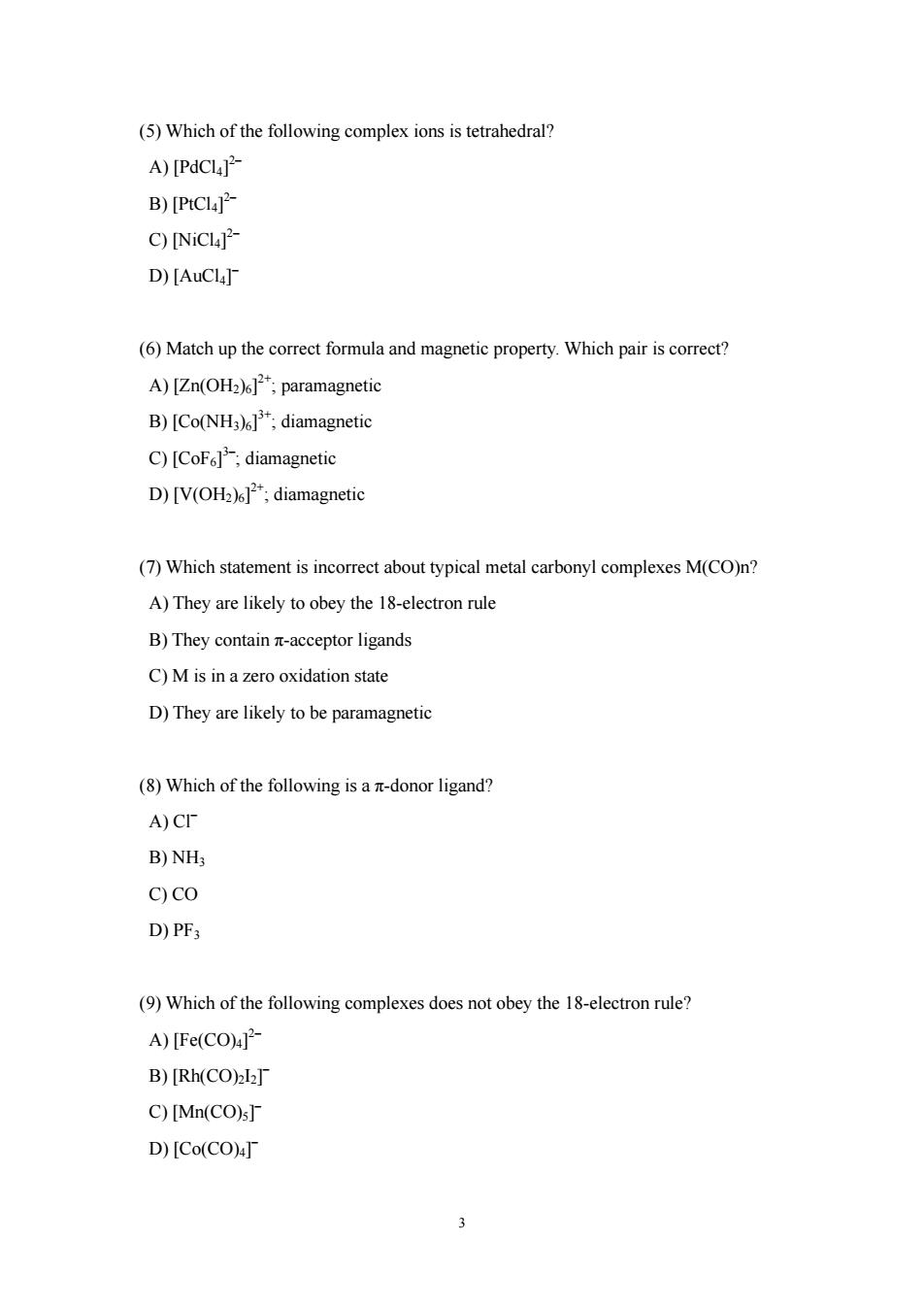
(5)Which of the following complex ions is tetrahedral? A)[PdCL]- B)[PtCla- C)[NiCl]- D)[AuCl4] (6)Match up the correct formula and magnetic property.Which pair is correct? A)[Zn(OH2)];paramagnetic B)[Co(NH3)];diamagnetic C)[CoF]diamagnetic D)[V(OH2)diamagnetic (7)Which statement is incorrect about typical metal carbonyl complexes M(CO)n? A)They are likely to obey the 18-electron rule B)They contain -acceptor ligands C)M is in a zero oxidation state D)They are likely to be paramagnetic (8)Which of the following is a -donor ligand? A)cr B)NH c)co D)PF3 (9)Which of the following complexes does not obey the 18-electron rule? A)[Fe(CO)4 B)[Rh(CO)2I2 C)[Mn(CO)s D)[Co(CO)4
(5) Which of the following complex ions is tetrahedral? A) [PdCl4] 2– B) [PtCl4] 2– C) [NiCl4] 2– D) [AuCl4] – (6) Match up the correct formula and magnetic property. Which pair is correct? A) [Zn(OH2)6] 2+; paramagnetic B) [Co(NH3)6] 3+; diamagnetic C) [CoF6] 3–; diamagnetic D) [V(OH2)6] 2+; diamagnetic (7) Which statement is incorrect about typical metal carbonyl complexes M(CO)n? A) They are likely to obey the 18-electron rule B) They contain π-acceptor ligands C) M is in a zero oxidation state D) They are likely to be paramagnetic (8) Which of the following is a π-donor ligand? A) Cl– B) NH3 C) CO D) PF3 (9) Which of the following complexes does not obey the 18-electron rule? A) [Fe(CO)4] 2– B) [Rh(CO)2I2] – C) [Mn(CO)5] – D) [Co(CO)4] – 3

(10)Which of the following statements is incorrect? A)The electronic spectrum of [Ni(NH3)6 contains 3 absorptions B)Absorptions in the electronic spectrum of [Mn(extremely weak C)For a tetrahedral d4 complex.3 absorptions are expected in its electronic spectrum D)The absorption in the electronic spectrum of [Ti(His assigned to the E T2gtransition (11)[Cr(CN)6]is expected to be: A)paramagnetic with e≈3.87μB B)diamagnetic C)paramagnetic with Her3.87 uB (12)Which series correctly places the ligands in order of increasing nephelauxetic effect? A)F[Co(NH) B)[Fe(CN)>[Fe(CN)] C)[Cr(OH2)>[Cr(OH2)] D)[CrFs]>[Cr(CN)] (14)The CFSE for a high-spin d4 octahedral complex is: A)-0.6At B)-1.8Ac
(10) Which of the following statements is incorrect? A) The electronic spectrum of [Ni(NH3)6] 2+ contains 3 absorptions B) Absorptions in the electronic spectrum of [Mn(OH2)6] 2+ are extremely weak C) For a tetrahedral d4 complex, 3 absorptions are expected in its electronic spectrum D) The absorption in the electronic spectrum of [Ti(OH2)6] 3+ is assigned to the Eg ← T2g transition (11) [Cr(CN)6] 3– is expected to be: A) paramagnetic with μeff ≈ 3.87 μB B) diamagnetic C) paramagnetic with μeff 3.87 μB (12) Which series correctly places the ligands in order of increasing nephelauxetic effect? A) F- [Co(NH3)6] 3+ B) [Fe(CN)6] 4– > [Fe(CN)6] 3– C) [Cr(OH2)6] 2+ > [Cr(OH2)6] 3+ D) [CrF6] 3– > [Cr(CN)6] 3– (14) The CFSE for a high-spin d4 octahedral complex is: A) –0.6Δoct B) –1.8Δoct 4
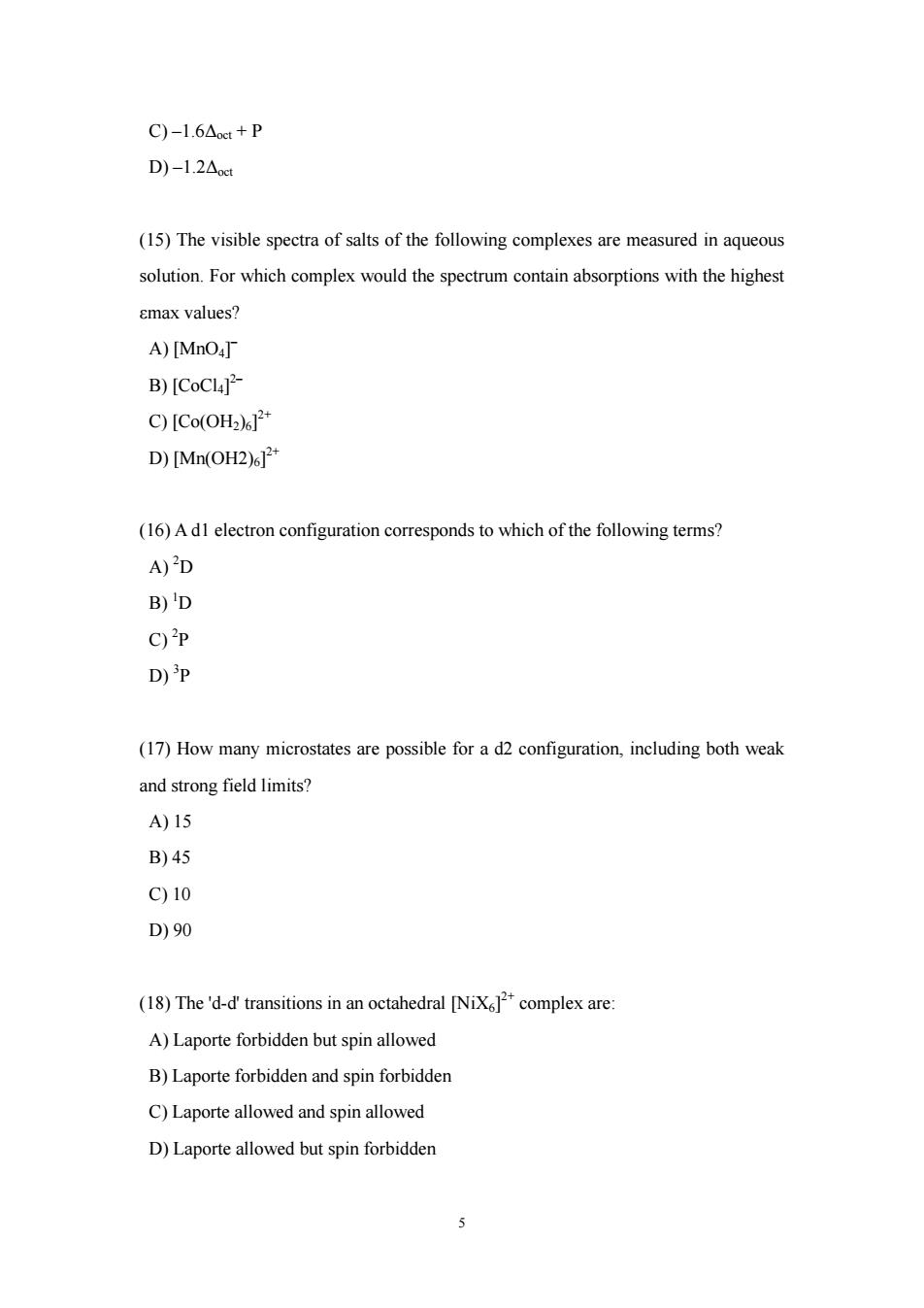
C)-1.6Aoct+P D)-1.2△i (15)The visible spectra of salts of the following complexes are measured in aqueous solution.For which complex would the spectrum contain absorptions with the highest emax values? A)[MnO4 B)[CoCL]2- C)[Co(OH2) D)[Mn(OH2)612* (16)Adl electron configuration corresponds to which of the following terms? A)D B)'D C)P D)P (17)How many microstates are possible for a d2 configuration,including both weak and strong field limits? A)15 B)45 C)10 D)90 (18)The'd-d'transitions in an octahedral [NiXcomplex are: A)Laporte forbidden but spin allowed B)Laporte forbidden and spin forbidden C)Laporte allowed and spin allowed D)Laporte allowed but spin forbidden
C) –1.6Δoct + P D) –1.2Δoct (15) The visible spectra of salts of the following complexes are measured in aqueous solution. For which complex would the spectrum contain absorptions with the highest εmax values? A) [MnO4] – B) [CoCl4] 2– C) [Co(OH2)6] 2+ D) [Mn(OH2)6] 2+ (16) A d1 electron configuration corresponds to which of the following terms? A) 2 D B) 1 D C) 2 P D) 3 P (17) How many microstates are possible for a d2 configuration, including both weak and strong field limits? A) 15 B) 45 C) 10 D) 90 (18) The 'd-d' transitions in an octahedral [NiX6] 2+ complex are: A) Laporte forbidden but spin allowed B) Laporte forbidden and spin forbidden C) Laporte allowed and spin allowed D) Laporte allowed but spin forbidden 5
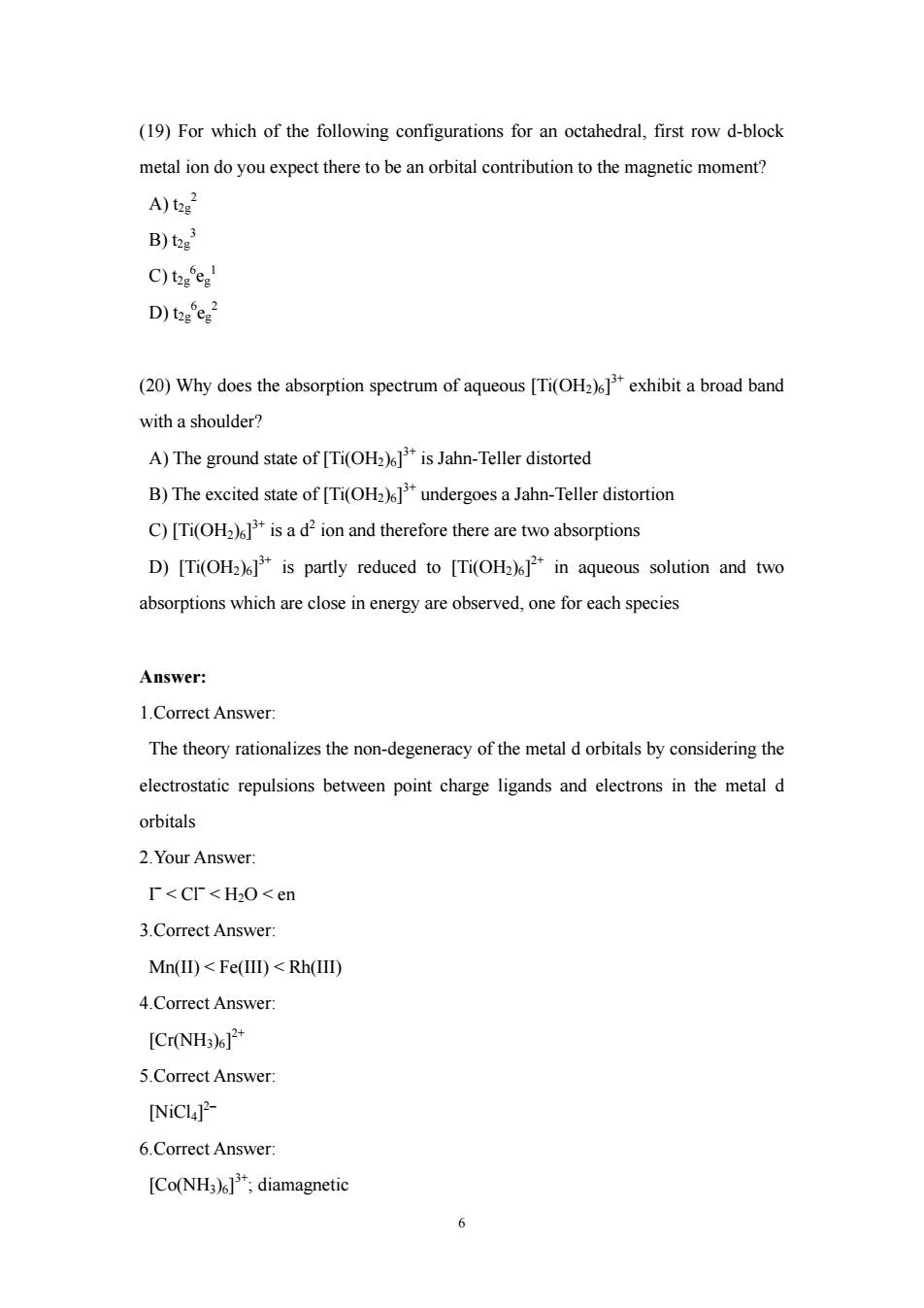
(19)For which of the following configurations for an octahedral,first row d-block metal ion do you expect there to be an orbital contribution to the magnetic moment? A)t2g2 B)t2g C)tzgeg D)tgeg2 (20)Why does the absorption spectrum of aqueous [Ti(OH2)6]exhibit a broad band with a shoulder? A)The ground state of [Ti(His Jahn-Teller distorted B)The excited state of [iH)undergoesa Jahn-Teller distortion C)i(Hisad2ion and therefore there are two absorptions D)[Ti(OH2)]is partly reduced to [Ti(H)in aqueous solution and two absorptions which are close in energy are observed,one for each species Answer: 1.Correct Answer The theory rationalizes the non-degeneracy of the metald orbitals by considering the electrostatic repulsions between point charge ligands and electrons in the metal d orbitals 2.Your Answer: r<Cr<H2O<en 3.Correct Answer: Mn(ID<Fe(II)<Rh(ID) 4.Correct Answer [Cr(NH3)6P 5.Correct Answer: [NiCl]2- 6.Correct Answer: [Co(NH)diamagnetic
(19) For which of the following configurations for an octahedral, first row d-block metal ion do you expect there to be an orbital contribution to the magnetic moment? A) t2g 2 B) t2g 3 C) t2g 6 eg 1 D) t2g 6 eg 2 (20) Why does the absorption spectrum of aqueous [Ti(OH2)6] 3+ exhibit a broad band with a shoulder? A) The ground state of [Ti(OH2)6] 3+ is Jahn-Teller distorted B) The excited state of [Ti(OH2)6] 3+ undergoes a Jahn-Teller distortion C) [Ti(OH2)6] 3+ is a d2 ion and therefore there are two absorptions D) [Ti(OH2)6] 3+ is partly reduced to [Ti(OH2)6] 2+ in aqueous solution and two absorptions which are close in energy are observed, one for each species Answer: 1.Correct Answer: The theory rationalizes the non-degeneracy of the metal d orbitals by considering the electrostatic repulsions between point charge ligands and electrons in the metal d orbitals 2.Your Answer: I– < Cl– < H2O < en 3.Correct Answer: Mn(II) < Fe(III) < Rh(III) 4.Correct Answer: [Cr(NH3)6] 2+ 5.Correct Answer: [NiCl4] 2– 6.Correct Answer: [Co(NH3)6] 3+; diamagnetic 6
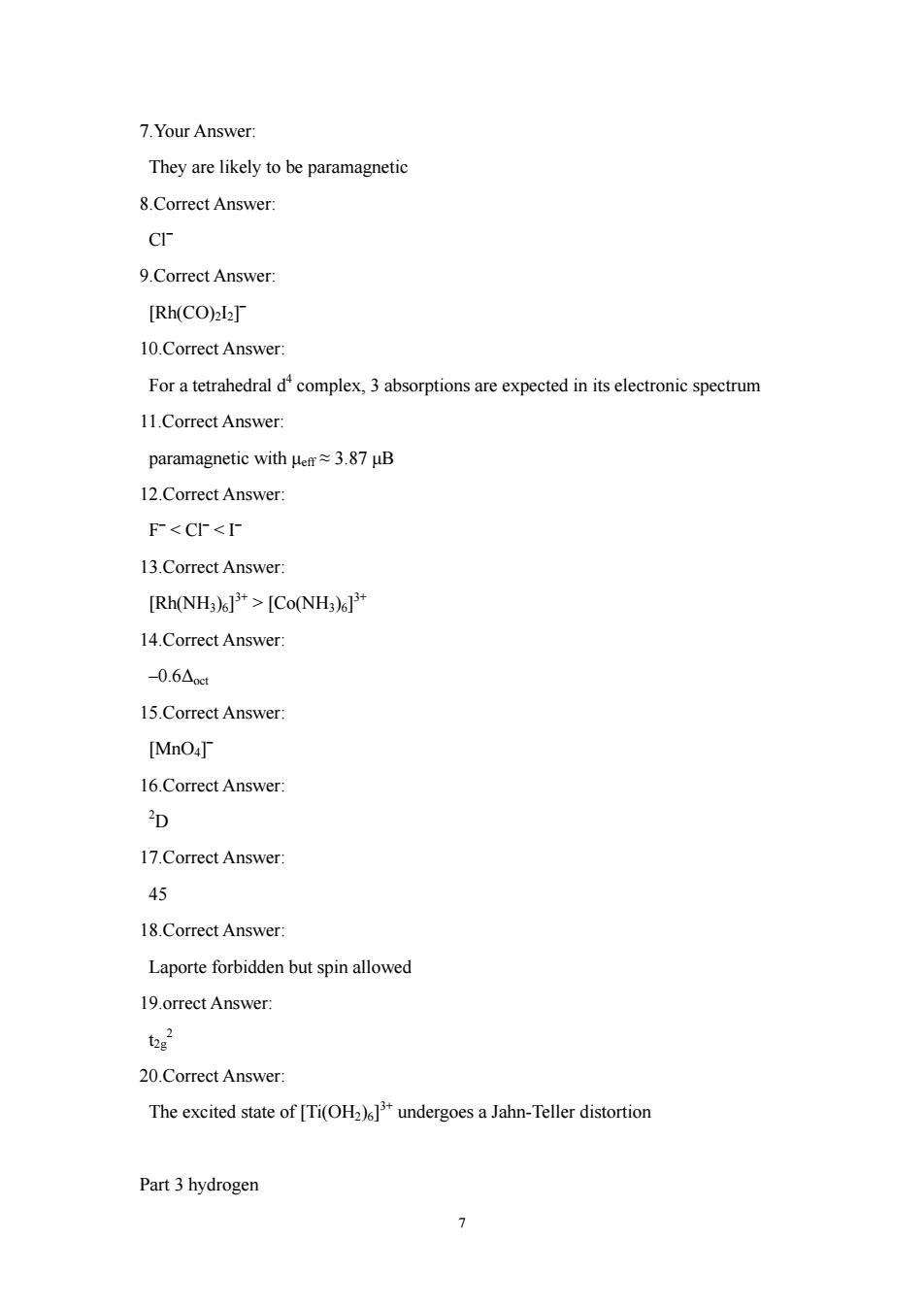
7.Your Answer: They are likely to be paramagnetic 8.Correct Answer 9.Correct Answer: [Rh(CO)2I2 10.Correct Answer For a tetrahedraldcomplex,3 absorptions are expected in its electronic spectrum 11.Correct Answer: paramagnetic with e3.87 uB 12.Correct Answer F[Co(NH3)6] 14.Correct Answer: -0.6Ag 15.Correct Answer: [MnO4 16.Correct Answer: 20 17.Correct Answer: 5 18.Correct Answer: Laporte forbidden but spin allowed 19.orrect Answer: 20.Correct Answer: The excited state of [Ti(OH2)]undergoes a Jahn-Teller distortion Part 3 hydrogen 7
7.Your Answer: They are likely to be paramagnetic 8.Correct Answer: Cl– 9.Correct Answer: [Rh(CO)2I2] – 10.Correct Answer: For a tetrahedral d4 complex, 3 absorptions are expected in its electronic spectrum 11.Correct Answer: paramagnetic with μeff ≈ 3.87 μB 12.Correct Answer: F– [Co(NH3)6] 3+ 14.Correct Answer: –0.6Δoct 15.Correct Answer: [MnO4] – 16.Correct Answer: 2 D 17.Correct Answer: 45 18.Correct Answer: Laporte forbidden but spin allowed 19.orrect Answer: t2g 2 20.Correct Answer: The excited state of [Ti(OH2)6] 3+ undergoes a Jahn-Teller distortion Part 3 hydrogen 7
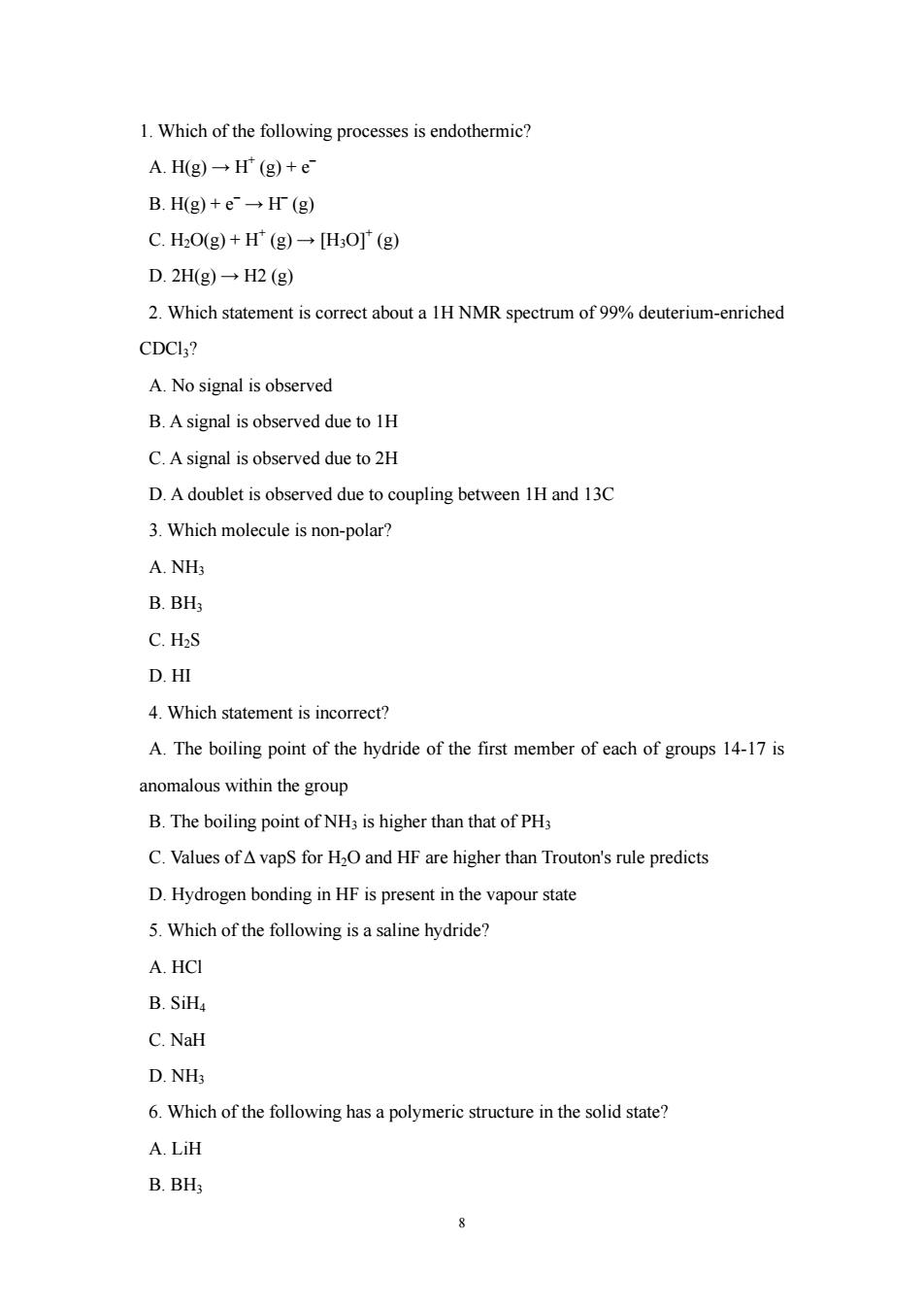
1.Which of the following processes is endothermic? A.H(g)→(g)+e B.H(g)+e→f(g) C.H0g)+(g)→H,O(g) D.2Hg)→H2(g) 2.Which statement is correct about a 1H NMR spectrum of 99%deuterium-enriched CDCI3? A.No signal is observed B.A signal is observed due to IH C.Asignal is observed due to 2H D.A doublet is observed due to coupling between IH and 13C 3.Which molecule is non-polar? A.NHs B.BH C.H2S D.HI 4.Which statement is incorrect? A.The boiling point of the hydride of the first member of each of groups 14-17 is anomalous within the group B.The boiling point of NH3 is higher than that of PH3 C.Values of AvapS for HO and HF are higher than Trouton's rule predicts D.Hydrogen bonding in HF is present in the vapour state 5.Which of the following is a saline hydride? A.HCI B.SiHa C.NaH D.NH; 6.Which of the following has a polymeric structure in the solid state? A.LiH B.BHs
1. Which of the following processes is endothermic? A. H(g) → H+ (g) + e– B. H(g) + e– → H– (g) C. H2O(g) + H+ (g) → [H3O]+ (g) D. 2H(g) → H2 (g) 2. Which statement is correct about a 1H NMR spectrum of 99% deuterium-enriched CDCl3? A. No signal is observed B. A signal is observed due to 1H C. A signal is observed due to 2H D. A doublet is observed due to coupling between 1H and 13C 3. Which molecule is non-polar? A. NH3 B. BH3 C. H2S D. HI 4. Which statement is incorrect? A. The boiling point of the hydride of the first member of each of groups 14-17 is anomalous within the group B. The boiling point of NH3 is higher than that of PH3 C. Values of Δ vapS for H2O and HF are higher than Trouton's rule predicts D. Hydrogen bonding in HF is present in the vapour state 5. Which of the following is a saline hydride? A. HCl B. SiH4 C. NaH D. NH3 6. Which of the following has a polymeric structure in the solid state? A. LiH B. BH3 8

C.BeH2 D.H2Se 7.How many Henvironments are present in the static structure of [ReH? A.9 B.3 C.2 D.1 8.What is the coordination number ofAl in the solid state structure of AlH3? A.4 B.6 c.8 D.12 9.The reaction of Ph2PH with BuLi would: A.produce LiPPhz B.liberate H2 C.produce Ph2BuP D.produce LiH 10.Which statement is incorrect about the reaction of N2 and H2 to give NH3? A.The forward reaction is exothermic B.AS for the forward reaction is positive C.The reaction is used commercially to manufacture NH3 but requires harsh conditions and a catalyst D.The reaction is extremely slow at 298K and 1 bar pressure 11.All the following hydrogen-bonded interactions have been observed in the solid state.Which of the following is likely to be the weakest? A.C-H---O B.N-H---O C.0-H-0 D.O-H---N 12.Which statement is incorrect?
C. BeH2 D. H2Se 7. How many H environments are present in the static structure of [ReH9] 2–? A. 9 B. 3 C. 2 D. 1 8. What is the coordination number of Al in the solid state structure of AlH3? A. 4 B. 6 C. 8 D. 12 9. The reaction of Ph2PH with BuLi would: A. produce LiPPh2 B. liberate H2 C. produce Ph2BuP D. produce LiH 10. Which statement is incorrect about the reaction of N2 and H2 to give NH3? A. The forward reaction is exothermic B. ΔS for the forward reaction is positive C. The reaction is used commercially to manufacture NH3 but requires harsh conditions and a catalyst D. The reaction is extremely slow at 298 K and 1 bar pressure 11. All the following hydrogen-bonded interactions have been observed in the solid state. Which of the following is likely to be the weakest? A. C–H---O B. N–H---O C. O–H---O D. O–H---N 12. Which statement is incorrect? 9
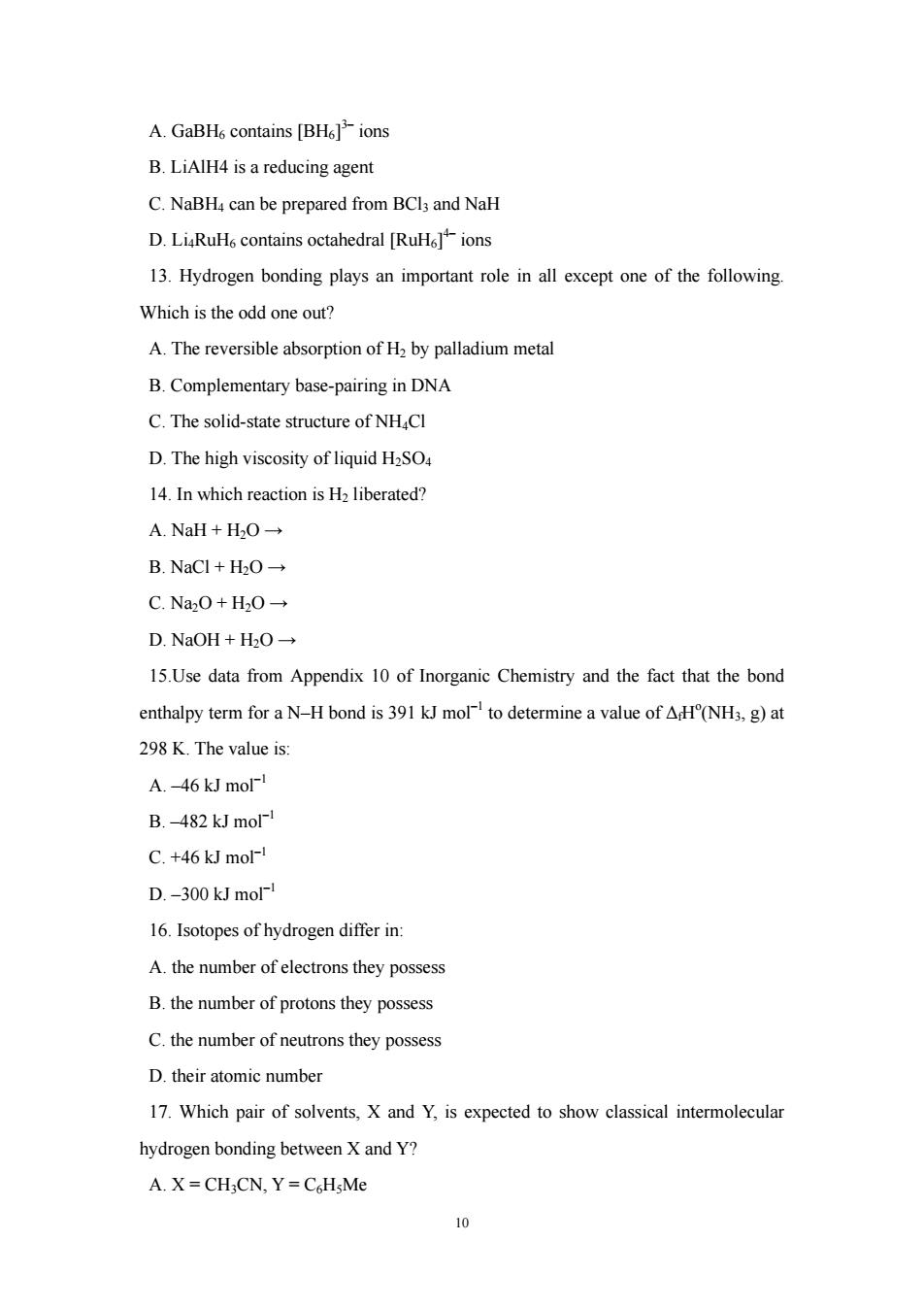
A.GaBH6 contains [BH6]ions B.LiAlH4 is a reducing agent C.NaBH can be prepared from BCl3 and NaH D.LiRuH.contains octahedral [RuHions 13.Hydrogen bonding plays an important role in all except one of the following. Which is the odd one out? A.The reversible absorption of Ha by palladium metal B.Complementary base-pairing in DNA C.The solid-state structure of NH.Cl D.The high viscosity of liquid HSO 14.In which reaction is H2 liberated? A.NaH+HO→ B.NaC1+H0→ C.Na20+H20→ D.NaOH+H,O→ 15.Use data from Appendix 10 of Inorganic Chemistry and the fact that the bond enthalpy term for a N-H bond is 391 kJ molto determine a value of(NH3.g)at 298K.The value is: A.-46 kJ mol-! B.-482 kJ mol- C.+46 kJ mol-! D.-300 kJmol- 16.Isotopes of hydrogen differ in: A.the number of electrons they possess B.the number of protons they possess C.the number of neutrons they possess D.their atomic number 17.Which pair of solvents,X and Y,is expected to show classical intermolecular hydrogen bonding between X and Y? A.X=CH;CN,Y=CoHsMe
A. GaBH6 contains [BH6] 3– ions B. LiAlH4 is a reducing agent C. NaBH4 can be prepared from BCl3 and NaH D. Li4RuH6 contains octahedral [RuH6] 4– ions 13. Hydrogen bonding plays an important role in all except one of the following. Which is the odd one out? A. The reversible absorption of H2 by palladium metal B. Complementary base-pairing in DNA C. The solid-state structure of NH4Cl D. The high viscosity of liquid H2SO4 14. In which reaction is H2 liberated? A. NaH + H2O → B. NaCl + H2O → C. Na2O + H2O → D. NaOH + H2O → 15.Use data from Appendix 10 of Inorganic Chemistry and the fact that the bond enthalpy term for a N–H bond is 391 kJ mol–1 to determine a value of ΔfHo (NH3, g) at 298 K. The value is: A. –46 kJ mol–1 B. –482 kJ mol–1 C. +46 kJ mol–1 D. –300 kJ mol–1 16. Isotopes of hydrogen differ in: A. the number of electrons they possess B. the number of protons they possess C. the number of neutrons they possess D. their atomic number 17. Which pair of solvents, X and Y, is expected to show classical intermolecular hydrogen bonding between X and Y? A. X = CH3CN, Y = C6H5Me 10